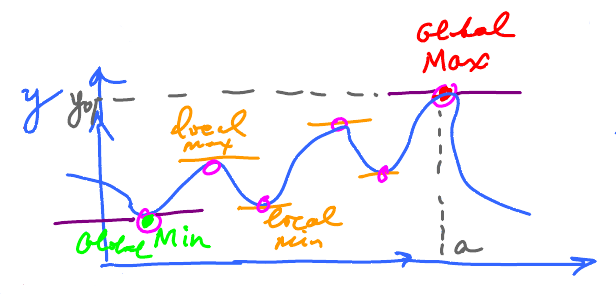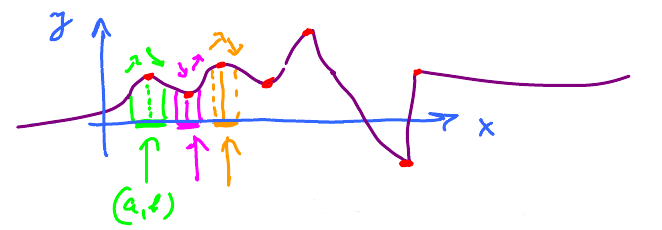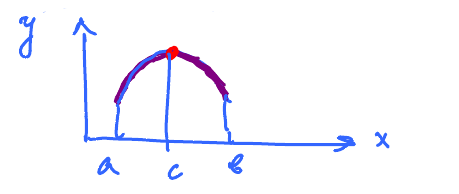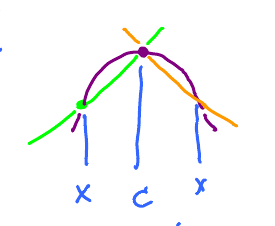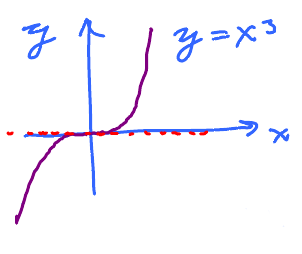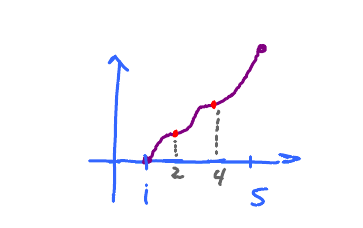This site is being phased out.
Difference between revisions of "Using derivative to find extreme values"
imported>WikiSysop |
(No difference)
|
Latest revision as of 15:17, 12 July 2011
We know that it might be possible to find maximum and minimum values of functions, if the functions are continuous.
Now practically, how can we use the derivative, $f^{\prime}$, to find global max/min?
Recall, these special points have horizontal tangents or they have no tangents at all.
So, we need to find all $x$'s such that
- $f^{\prime}(x) = 0$, or
- $f^{\prime}(x)$ does not exist, or
- $x$ is $a$ or $b$ (if the domain is $[a,b]$ etc).
But what exactly does this give us? The derivative $f^{\prime}(c)$ is defined as a limit with $x$ approaching $c$. This is why it reflects only the behavior of $f$ close to $c$:
The idea of getting only the values of $f(x)$ for $x$ close to $c$ is presented more precisely in
- Definition
- A function $f$ has a local minimum point at $x = c$ if
- $f(a) \leq f(x)$ for all $x$ ... (no not all!)
in some interval $(a, b)$ that contains $c$. ("some" = "there is")
Example: Local Max and Min
- Definition
- A function $f$ has a local maximum point at $x = c$ if
- $f(a) \geq f(x)$ for all $x$ in some interval $(a, b)$ that contains $c$.
We have found above: local max, min, max, min, etc. Around each of these points we see:
- $\nearrow \searrow$ or $\nearrow \searrow$.
They correspond to max or min respectively.
Now, how do we find these points?
Claim: $f^{\prime}(c) = 0.$
Why? If not: $f^{\prime}(c) > 0$ or $f^{\prime}(c) < 0$. And there is no max or min!
"Formal" proof next.
Recall, $f^{\prime}(c)$ is the limit of slopes of the secant lines.
Consider secant lines on
- A: the left of $c$ (green): $\text{slope} \geq 0$.
- B: The right of $c$ (orange): $\text{slope} \leq 0$.
Recall: $$g(x) \geq 0 \Rightarrow \lim\limits_{x \to c} g(x)\geq 0.$$
We use this fact to conclude:
- A. implies that $f^{\prime}(c) \geq 0$.
- B. implies that $f^{\prime}(c) \leq 0.$
Simultaneously!
Therefore, $$f^{\prime}( c ) = 0.$$
To complete proof, we need to prove algebraically that $\text{slopes of secants } \geq 0, \leq 0$.
Take any (secant) line through $(x, f(x))$ and $(c,f(c)), x < c$. Then $$ f(x) \leq f(c)$$ if $x$ is close enough to $c$. Why? Because $c$ is a local max (review the definition). Now $$ \text{Slope } = \frac{\overbrace{f(c) - f(x)}^{\text{positive}}}{\underbrace{c - x}_{\text{positive}}}.$$ Observe that the numerator and denominator are positive, so the slope is positive.
Now take any (secant) line through $(x, f(x))$ and $(c,f(c)), x > c$. Then $$ f(x) \leq f(c) $$ if $x$ is close enough to $c$. Vecause $c$ is a local max. Then $$ \text{Slope } = \frac{\overbrace{f(c) - f(x)}^{\text{positive}}}{\underbrace{c - x}_{\text{negative}}}$$ Observe that the numerator and denominator are positive, so the slope is negative. $\blacksquare$
Let's formalize this result.
Fermat’s Theorem. Suppose $c$ is a local extreme point of $y = f(x)$. Then $$\left.\begin{aligned} f^{\prime}(c) & = 0 \quad \text{ or } \\ f^{\prime}(c) & \text{ does not exist.} \end{aligned} \right\} $$ In this case $c$ is is called a critical point.
Plan: To find global max/min, find all critical points.
Q: What about vice versa? Is the "converse" below of the theorem true?
$f^{\prime}(c) = 0$ then $c$ is a local extreme point of $f$.
A: Not true!
Example. Consider $f(x) = x^{3}$ at $x = 0$
$$\begin{aligned} f^{\prime}(x) &= 3x^{2} \\ f^{\prime}(0) & = 0, \end{aligned}$$ but this is not an extreme point.
Example. A more extreme example...
Verify.
Example: Global Extreme Points.
Find global extreme points of $y = f(x) = x^{3} - x$ on $[-2, 5]$.
Step 1: Find all critical points.
How? Use Fermat's theorem.
Compute: $$ f^{\prime}(x) = 3x^{2} - 1 $$ Set it to 0, and solve for $x$. $$\begin{aligned} 3x^{2} - 1 &= 0 \\ x^{2} &= \frac{1}{3} \\ x & = \pm \frac{1}{\sqrt{3}} \end{aligned}$$ There are 2 critical points.
Step 2: Compare the values of $f$ at these points and the end points of the interval, find the smallest and the largest:
| $ $ | $x$ | $y = x^{3} - x = x(x^{2} - 1)$ |
|---|---|---|
| Critical Points | $\frac{1}{\sqrt{3}}$ | $\frac{1}{\sqrt{3}}\left(\frac{1}{3} - 1 \right) = -\frac{2}{3\sqrt{3}}$ |
| Critical Points | $\frac{1}{\sqrt{3}}$ | $-\frac{1}{\sqrt{3}}\left(-\frac{1}{3} - 1 \right) = \frac{2}{3\sqrt{3}}$ |
| End Points | $-2$ | $8 + 2 = -5 \gets \text{ global min }$ |
| End Points | $5$ | $12.5 - 5 = 120 \gets \text{ global max }$ |
The critical points are visible on the graph:
Recall: $$\lim_{x \to \pm\infty}(x^{3} - x) = \pm\infty.$$
Example: No Local Max/Min
Plot with no local max/min showing critical points at 2, 4. Graph is continuous on $[1,5]$.
Exercise. Analyze the function (algebraically): $$f(x) = 2x^{3} - 3x^{2} - 12x + 1 $$ on $[-2,3]$.
Compute: $$f^{\prime}(x) = 6x^{2} - 6x - 12 $$ defined for all $x$. Solve $$\begin{aligned} 6x^{2} - 6x - 12 &= 0 \\ x^{2} -x - 2 &= 0 \\ \text{QF} \qquad x &= \frac{1 \pm \sqrt{1 - (-2)4}}{2} \\ &= \frac{1 \pm 3}{2} = 2,1 \end{aligned}$$
Compare:
| $ $ | $x$ | $y$ |
|---|---|---|
| Critical Points | 2 | $2\cdot 2^{3} - 3 \cdot 2^{2} - 12 \cdot 2 + 1 = 16 - 12 - 24 + 1 = -19$ |
| Critical Points | -1 | $2\cdot (-1)^{3} - 3 \cdot (-1)^{2} - 12 \cdot (-1) + 1 = -2 - 3 +12 + 1 = 8$ |
| End Points | -2 | $2\cdot (-2)^{3} - 3 \cdot (-2)^{2} - 12 \cdot (-2) + 1 = -16 - 12 + 24 + 1 = -3$ |
| End Points | 3 | $2\cdot 3^{3} - 3 \cdot 3^{2} - 12 \cdot 3 + 1 = 54 - 27 -36 + 1 = -8$ |
Answer
- Global max value is $y = 8$ attained at $x = -1$ (global max point).
- Global min value is $y = 19$ attained at $x = 2$ (global min point).
- Global max is visible as a point on the graph: (-1,8).
